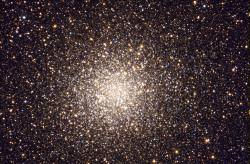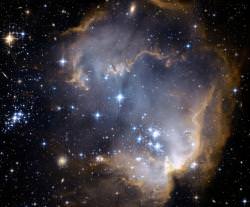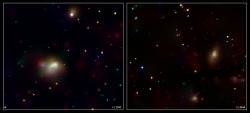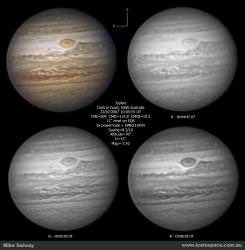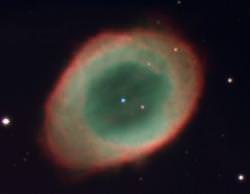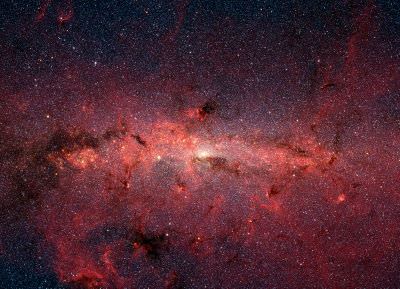Monday, July 30 – Today’s history celebrates the 2001 flyby of the Moon by the Wilkinson Microwave Anisotropy Probe (WMAP) on its way to Lagrange Point 2 to study the cosmic microwave background radiation. Tonight we’ll also fly right by the Full Buck Moon as we continue our studies to have a look at Mu 1 and Mu 2 Scorpii about two fingerwidths north of Zeta.
Very close to the same magnitude and spectral type, the twin Mu stars are easy to separate visually and most definitely worth a look in telescopes or binoculars. They are considered an actual physical pair because they share the exact same distance and proper motion, but they are separated by less than one light-year.
Hanging out in space some 520 light-years away, western Mu 1 is a spectroscopic binary – the very first discovered to have double lines. This Beta Lyrae-type star has an orbiting companion that eclipses it around every day and a half, yet causes no significant visual drop in magnitude – even though the orbiting companion is only 10 million kilometers away from it! While that sounds like plenty of distance, when the two pass, their surfaces would nearly touch each other!
Now, relax and enjoy the peak of the Capricornid meteor shower. Although it is hard for the casual observer to distinguish these meteors from the Delta Aquarids, no one minds. Again, face southeast and enjoy! The fall rate for this shower is around 10 to 35 per hour, but unlike the Aquarids, this stream produces those great “fireballs” known as bolides. Enjoy…
Tuesday, July 31 – Tonight with the slightly later rise of the Moon, we’ll take the opportunity to look at two multiple star systems – Nu and Xi Scorpii.
Starting with Nu about a fingerwidth east and slightly north of bright Beta, we find a handsome duo of stars in a field of nebulosity that will challenge telescopic observers much the way that Epsilon Lyrae does. With any small telescope, the observer will easily see the widely separated A and C stars. Add just a little power and take your time… The C star has a D companion to the southwest! For larger telescopes, take a very close look at the primary star. Can you separate the B companion to the south?
Now let’s hop to Xi about four fingerwidths north of Beta.
Discovered by Sir William Herschel in 1782, this 80 light-year distant system poses a nice challenge for mid-sized scopes. The yellow-hued A and B pair share a very eccentric orbit about the same distance as Uranus is from our Sun. During the 2007 observing year they should be fairly well spaced, and the slightly fainter secondary should appear to the north. Look a good distance away for the 7th magnitude orange C component and south for yet another closely-matched double of 7th and 8th magnitude – the D and E stars.
For the larger scope, this multiple star system does display a little bit of color. Most will see the A and B components as yellow/white, the C star as slightly orange, and the D/E pair as slightly tinged with blue. Be sure to mark your observations for this is one of the finest!
Wednesday, August 1 – Today is the birthdate of Maria Mitchell. Born in 1818, Mitchell became the first woman to be elected as an astronomer to the American Academy of Arts and Sciences. She later rocketed to worldwide fame when she discovered a bright comet in 1847.
Tonight, let’s continue our exploration of globular clusters. These gravitationally bound concentrations of stars contain anywhere from ten thousand to one million members and attain sizes of up to 200 light-years in diameter. At one time, these fantastic members of our galactic halo were believed to be round nebulae. Perhaps the very first to be discovered was M22 in by Abraham Ihle in 1665. This particular globular is easily seen in even small binoculars and can be located just slightly more than two degrees northeast of the “teapot’s lid,” Lambda Sagittarii.
Ranking third amongst the 151 known globular clusters in total light, M22 is probably the nearest of these incredible systems to our Earth with an approximate distance of 9600 light-years, and it is also one of the nearest globulars to the galactic plane. Since it resides less than a degree from the ecliptic, it often shares the same eyepiece field with a planet. At magnitude 6, the class VII M22 will begin to show individual stars to even modest instruments and will burst into stunning resolution for larger aperture. About a degree west-northwest, mid-sized telescopes and larger binoculars will capture smaller 8th magnitude NGC 6642. At class V, this particular globular will show more concentration toward the core region than M22. Enjoy them both!
Thursday, August 2 – As we know, most globular clusters congregate around the galactic center in the Ophiuchus/Sagittarius region. Tonight let’s explore what creates a globular cluster’s form… We’ll start with the “head of the class,” M75.
Orbiting the galactic center for billions of years, globular clusters endured a wide variety of disturbances. Their component stars escape when accelerated by mutual encounters and the tidal force of our own Milky Way pulls them apart when they are near periapsis, that is, closest to the galactic center. Even close encounters with other masses, such as other clusters and nebulae, can affect them! At the same time, their stellar members are also evolving and this loss of gas can contribute to mass loss and deflation of these magnificent clusters. Although this happens far less quickly than in open clusters, our observable globular friends may only be the survivors of a once larger population, whose stars have been spread throughout the halo. This destruction process is never-ending, and it is believed that globular clusters will cease to exist in about 10 billion years.
Although it will be later evening when M75 appears on the Sagittarius/Capricornus border, you will find the journey of about 8 degrees southwest of Beta Capricorni worth the wait. At magnitude 8, it can be glimpsed as a small round patch in binoculars, but a telescope is needed to see its true glory. Residing around 67,500 light-years from our solar system, M75 is one of the more remote of Messier’s globular clusters. Since it is so far from the galactic center – possibly 100,000 light-years distant – M75 has survived almost intact for billions of years to remain one of the few Class I globular clusters. Although resolution is possible in very large scopes, note that this globular cluster is one of the most concentrated in the sky, with only the outlying stars resolvable to most instruments.
Friday, August 3 – Tonight let’s return to earlier evening skies as we continue our studies with one of the globulars nearest to the galactic center – M14. Located about sixteen degrees (less than a handspan) south of Alpha Ophiuchi, this ninth magnitude, class VIII cluster can be spotted with larger binoculars, but will only be fully appreciated with the telescope.
When studied spectroscopically, globular clusters are found to be much lower in heavy element abundance than stars such as own Sun. These earlier generation stars (Population II) began their formation during the birth of our galaxy, making globular clusters the oldest of formations that we can study. In comparison, the disk stars have evolved many times, going through cycles of starbirth and supernovae, which in turn enrich the heavy element concentration in star forming clouds and may cause their collapse. Of course, as you may have guessed, M14 breaks the rules. It contains an unusually high number of variable stars – in excess of 70 – with many of them known to be the W Virginis type. In 1938, a nova appeared in M14, but it was undiscovered until 1964 when Amelia Wehlau of the University of Ontario was surveying the photographic plates taken by Helen Sawyer Hogg. The nova was revealed on eight of these plates taken on consecutive nights, and showed itself as a 16th magnitude star – and was believed to be at one time almost 5 times brighter than the cluster members. Unlike 80 years earlier with T Scorpii in M80, actual photographic evidence of the event existed. In 1991, the eyes of the Hubble were turned its way, but neither the suspect star nor traces of a nebulous remnant were discovered. Then six years later, a carbon star was discovered in M14.
To a small telescope, M14 will offer little to no resolution and will appear almost like an elliptical galaxy, lacking in any central condensation. Larger scopes will show hints of resolution, with a gradual fading towards the cluster’s slightly oblate edges. A true beauty!
Saturday, August 4 – As we explore globular clusters, we simply assume them all to be part of the Milky Way galaxy, but that might not always be the case. We know they are basically concentrated around the galactic center, but there may be four of them that actually belong to another galaxy. Tonight we’ll look at one such cluster being drawn into the Milky Way’s halo. Set your sights just about one and a half degrees west-southwest of Zeta Sagittarii for M54.
At around magnitude 7.6, M54 is definitely bright enough to be spotted in binoculars, but its rich class III concentration is more notable in a telescope. Despite its brightness and deeply concentrated core, M54 isn’t exactly easy to resolve. At one time we thought it to be around 65,000 light-years distant, and rich in variables – with 82 known RR Lyrae types. We knew it was receding, but when the Sagittarius Dwarf Elliptical Galaxy was discovered in 1994, it was noted that M54 was receding at almost precisely the same speed! When more accurate distances were measured, we found M54 to coincide with the SagDEG distance of 80-90,000 light-years, and M54’s distance is now calculated to be 87,400 light-years. No wonder it’s hard to resolve – it’s outside our galaxy!
Sunday, August 5 – Today we celebrate the 76th birthday of Neil Armstrong, the first human to walk on the moon. Congratulations! Also on this date in 1864, Giovanni Donati made the very first spectroscopic observations of a comet (Tempel, 1864 II). His observations of three absorption lines led to what we now know as the Swan bands, from a form of the carbon radical C2.
Our study continues tonight as we move away from the galactic center in search of a remote globular cluster that can be viewed by most telescopes. As we have learned, radial velocity measurements show us the majority of globulars are involved in highly eccentric elliptical orbits, which take them far outside the plane of the Milky Way. These orbits form a sort of spherical “halo” which tends to be more concentrated toward our galactic center. Reaching out several thousands of light-years, this halo is actually larger than the disk of our own galaxy. Since globular clusters aren’t involved in our galaxy’s disk rotation, they may possess very high relative velocities. Tonight let’s head toward the constellation of Aquila and look at one such globular – NGC 7006.
Located about half a fist’s width east of Gamma Aquilae, NGC 7006 is speeding towards us at a velocity of around 345 kilometers per second. At 150,000 light-years from the center of our galaxy, this particular globular could very well be an extra-galactic object. At magnitude 11.5, it’s not for the faint of heart, but can be spotted in scopes as small as 150mm, and requires larger aperture to look like anything more than a suggestion.
Given its tremendous distance from the galactic center, it’s not hard to realize this is a class I – although it is quite faint. Even the largest of amateur scopes will find it unresolvable!

